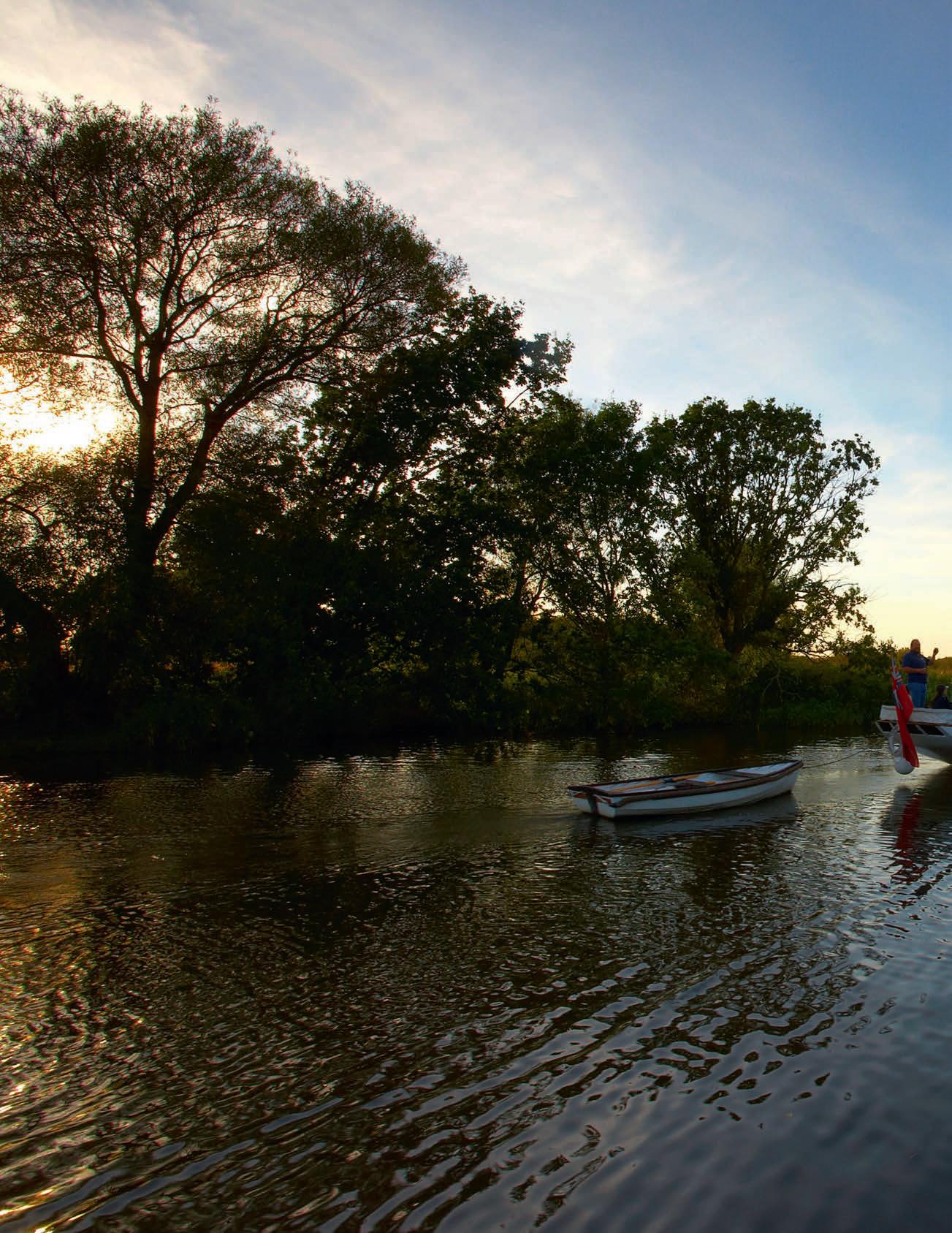
6 minute read
Dispatches: Norfolk
Back from the brink
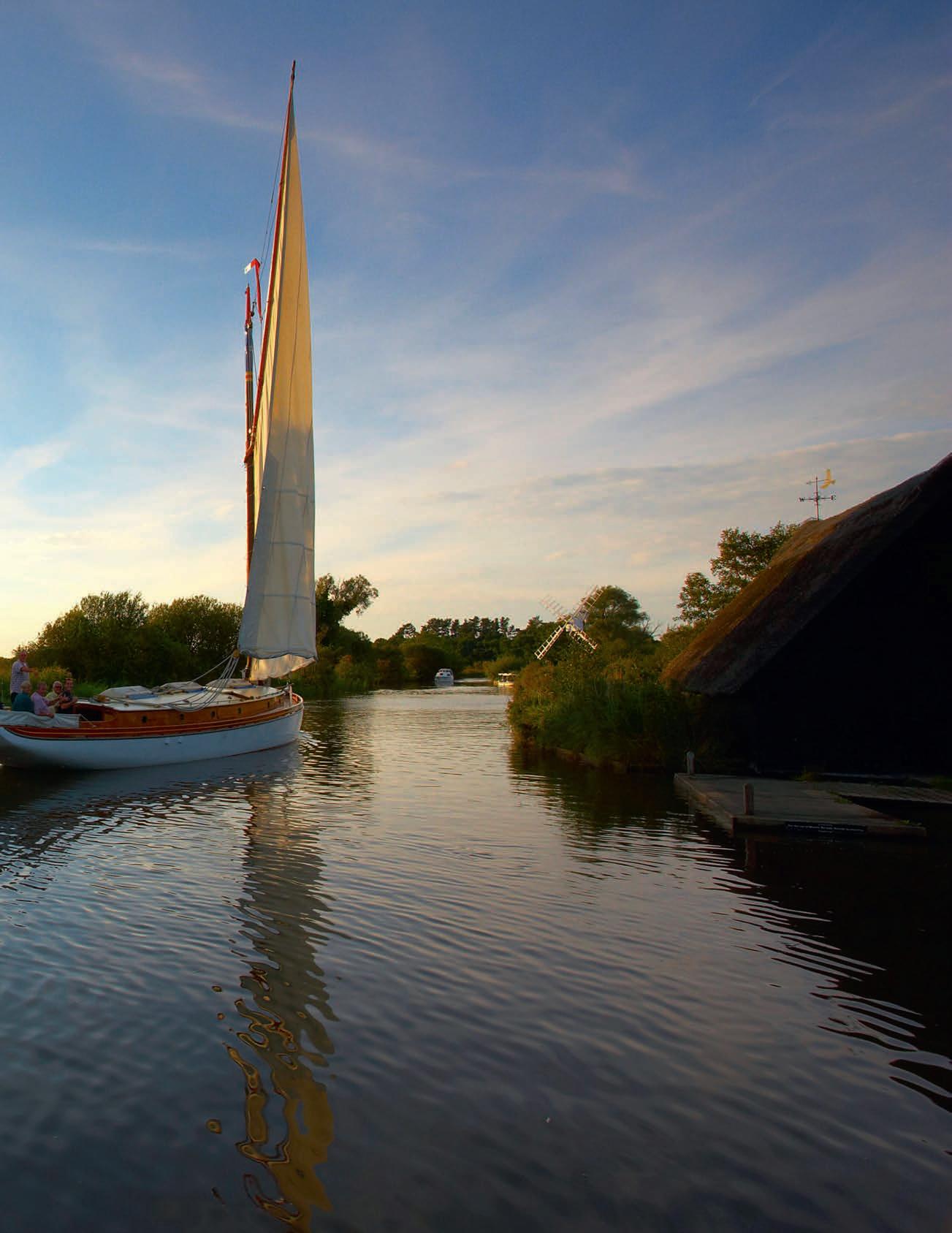
Advertisement
The wherry boats of Norfolk had their day and almost passed into history; now they’re bringing old-fashioned pleasure cruising back to the Broads, discovers Lyn Hughes
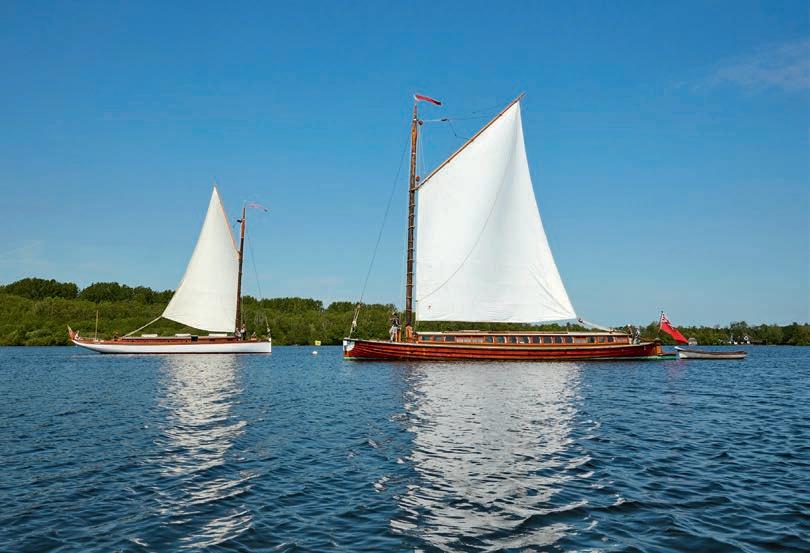
Life on the Broads (this page; clockwise from bottom left) the original brass bell from the Ardea; forget the 1920s celeb parties, pleasure cruising has become a family day out; swans cruise the Broads like gangs of pale delinquents; the lost art of quanting; you can see how streamlined the White Moth is when compared with the larger Ardea; (right page; clockwise from top left) the Egyptian-themed marquetry of the Hathor recalls the sad story of the Colman family; volunteers man the White Moth; the Hathor’s interior has inlaid lotus flowers of teak and dyed sycamore in the saloon, while animals and other symbols adorn the door; the Hathor can be visited at How Hill House
was then owned by a Frenchman for nearly 40 years and used as a char ter vessel around the canals of France, Belgium, the Netherlands and Germany, before being brought back to Norfolk in 2005 and restored to her former glory.
It was a warm August evening, so after dinner at a local pub, we headed back to the Ardea and sat on her roof. A few swans and ducks had milled around the boat earlier in the evening, but now a bevy of swans was gliding by – I lost count after 40 or so. I then realised that they were following a kayak that had stopped fur ther up to throw out food for them.
It was then time to lie back on the sloping roof and look to the skies. The Per seid meteor shower was already at its peak, and shooting stars were leaving trails across the heavens. With little light pollution, and the only sound that of lapping water, we each sank into a spellbound reverie.
Reluctantly deciding it was time for bed, I slept well in my wood-panelled state room, which was like a museum piece with its brass fittings, original wardrobe and cupboard. A hatch at one end would have been used for passing through drinks. A slightly raised area may have been where a cot lay, or a dog bed. After breakfast, we transferred to a yacht wherry, the White Moth. Dating back to 1915, she would have been built with racing in mind, and was the last yacht wherry to take to the water. After a chequered history of mixed fortunes – as a charter, a houseboat, being sunk and then neglected – she was restored to her former glory in the late 1980s. We headed off along the River Bure, and skipper Dean
“A shape arced Howard instructed two of our into view and party to get on the winch at the bow of the boat and wind
I grabbed my until the sail was raised. We all binoculars. It was smiled at the sight of the large an otter fishing by white sail standing proud as Dean tacked along the river. the banks” Our route was lined with holiday homes and desirable houses, most with characteristic thatched roofs made from local reeds. We even passed the mansion that belonged to the late George Formby. Pleasure boats went by, some with smiling passengers waving at us or taking a photograph; one or two impatiently tried to pass us despite the 4mph limit. Then the banks on each side got wilder and more natural, and we started to see herons, butterflies, wildflowers and dragonflies rather than other boats.
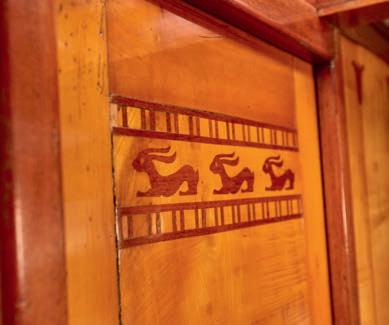

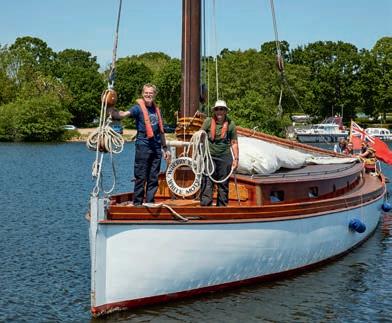
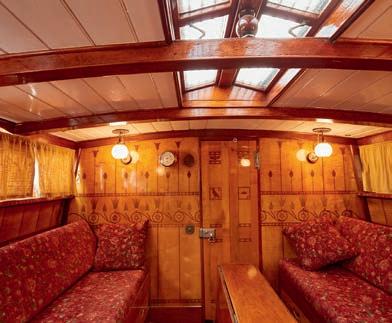
We turned onto Wroxham Broad, a lively wind blowing across its vast expanse. While people refer to the whole area as the Broads, a broad is the name given to the shallow lakes that pepper the area. It was finally proved in the 1960s that these were man-made rather than naturally occuring, and that they began as pits that had been dug for peat to provide fuel during medieval times.
In one area, dozens of children were having dinghy sailing lessons. In the distance, we could see another wherry, the privately-owned Solace. I found myself nodding to her. Dean manoeuvred the White Moth around the broad, using the wind to give us a taste of her speed under sail, and I marvelled at his handling of her as he stood braced against the tiller and seemed to be part of the wherry itself.
We headed to one side of the Broad and stopped for lunch in a secluded spot. As we munched on sandwiches, I kept watching the water between a fallen tree and the bank, curious at the ripples. A shape arced into view and I grabbed my binoculars. It was an otter, presumably fishing, and we all traced its progress for a while as the fish in its path jumped out of the water in an effort to get away.
We headed back to base but my weekend of wherries wasn’t yet over as I drove a few miles to How Hill, site of an educational trust and where another very special pleasure wherry was based for the summer. Dating back to 1905, the Hathor, named after the Egyptian goddess of love and beauty, was commissioned by the Colman family (of mustard fame). I hadn’t read up on her before my visit and, on boarding, I was startled by her dazzling interior, her sycamore-panelled walls embellished with Egyptian hieroglyphs formed by the use of inlaid teak.
The Hathor had been built in memory of Alan Colman, son of Jeremiah Colman, an MP and owner of the family company. In 1897, suffering from tuberculosis, he went to Egypt in an attempt to improve his health. The family chartered a dahabiyah, a traditional sailing barge, for a Nile cruise from Cairo to Luxor.
Alan sadly passed away a few days afterwards but his sisters, knowing how much he had loved the dahabiyah journey, commissioned the Hathor a few years later. Its interior was designed by prominent architect Edward Boardman, who married into the Colman family and lived in How Hill House, its Egyptian-themed symbols and fittings copied from originals on display in the British museum.
That night, I dreamt of young Alan Colman and his Nile cruise. And then the dream morphed into a sparkling party aboard the Ardea. I don't think I was in a flapper dress, but I will certainly make more of an effort to look the part next time I have the privilege of staying on her.
NEED TO KNOW
Wherry Yacht Charter
(wherryyachtcharter.org) offers a programme of day sailings and also private charters. The season for both is May to September but trips depend on skipper and crew availability. Up to ten passengers can be taken on day sailings and they cost £50 per person. Private day charters (up to 12 people) are £425 on weekdays, £450 at weekends. A weekend charter from Friday to Sunday evening costs £995 for a maximum of ten people. The wherries are offered on a self-catering basis and facilities include a fully equipped galley with hob, oven and fridge, a toilet, washbasins and a shower (White Moth only). Each saloon provides both daytime living space and four berths, and features a yacht piano. For overnight charters you need to provide your own bedding.
The Hathor (pictured below) is in residence at How Hill (howhilltrust.org. uk) for the summer (June to September), with staffed viewings from 10am to 5pm whenever volunteers are available and if she is not in use for sailing. Please contact the Trust to confirm availability if you are making a special trip. Viewings are always free, but donations are more than appreciated.










